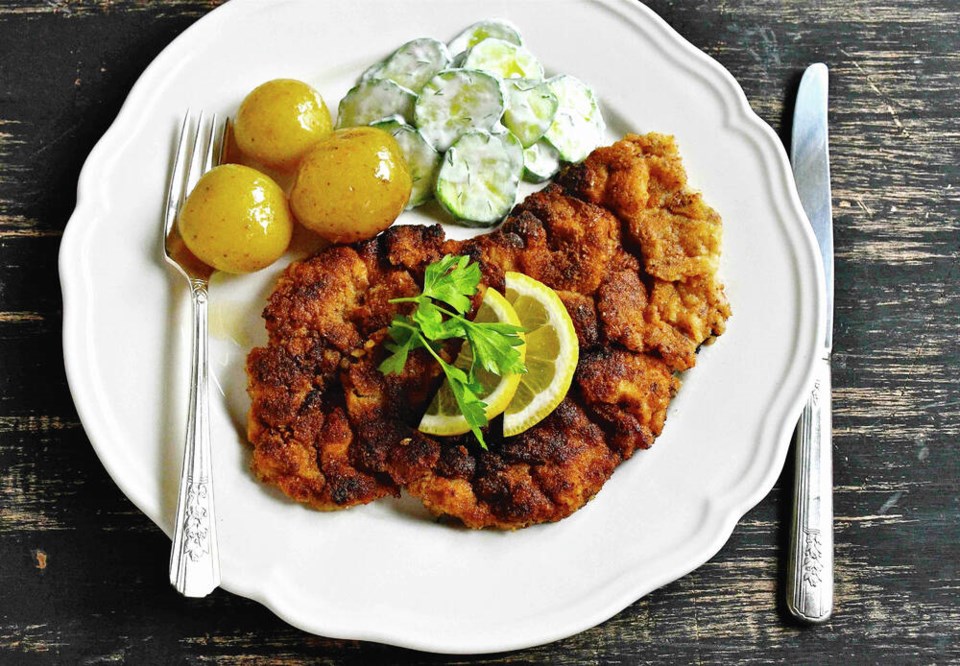Many things inspire the types of recipes I present in my column, and television food shows is one of them.
On that note, I was stirred to offer today’s dish after viewing an episode of chef Andrew Zimmern’s show called Bizarre Foods Delicious Destinations, which appears on the Cooking Channel. On that show Zimmern showcases the most popular foods served in cities across the world and in the episode I watched the focus was on Zurich and Munich.
While in the Munich area a segment of the show was filmed at a hotel called Kaiserin Elisabeth and in its restaurant they served Bavarian-style dishes, including Münchner schnitzel, or Munich-style schnitzel.
To make it, a pork cutlet was pounded until very thin and long and wide enough to almost fill a dinner plate. Like other types of schnitzels, the German word for cutlet, it was then breaded.
During that process, and what makes Münchner schnitzel different from other types, is that before the breadcrumbs are applied, the thin pork cutlet is spread with sweet, whole grain, Bavarian-style mustard and horseradish. It’s a sweet, spicy, mustardy combination that richly enhances the flavour of the pork.
On that show, after the schnitzel was coated and fried until golden, richly basted with melted butter and plated, it looked absolutely delicious. And, I said to myself, I have to try making Münchner schnitzel and not long after, I did.
The only problem was that when I went shopping for the ingredients I could not find any sweet Bavarian-style mustard for sale. So, I decided to sweeten the whole grain Dijon mustard I had at home with a bit brown sugar and it worked well.
Pounding, flavouring and breading the two schnitzels my recipe yields, work-wise, is a little messy. But the good news is you can coat the schnitzels in advance, tidy up your kitchen, and fry the schnitzels later, when it’s time for dinner.
I served my Münchner schnitzels with boiled potatoes and German-style cucumber salad, and garnished them with lemon slices and parsley sprigs, as is often done in restaurants. German-style beer, not surprisingly, is something that also goes well with Münchner schnitzel.
Münchner Schnitzel
Munich-style schnitzel richly flavoured with sweetened mustard, horseradish and melted butter.
Preparation time: 25 minutes
Cooking time: about 7 minutes
Makes: two servings
2 (about 5 ounce/140 gram) boneless pork leg cutlets, boneless pork loin chops, or boneless pork sirloin chops
• salt and freshly ground black pepper, to taste
1 large egg
2 Tbsp milk
1/4 cup all-purpose flour
2/3 to 1 cup dried, fine breadcrumbs
2 Tbsp whole grain Dijon mustard
2 tsp brown sugar
1 Tbsp horseradish
• vegetable oil
1 to 2 Tbsp butter, melted
• lemon slices and parsley sprigs, for garnish
Put a piece of parchment paper on a cutting board. Set a piece of the pork in the centre of the paper. Cover with a double layer of plastic wrap. Using a kitchen hammer, pound the pork until very thin, about 1/8- to 1/4-inch thick, and then set on a plate. Pound the other piece of pork in this fashion.
Place egg in a wide, shallow bowl or pieplate and beat well. Mix in the milk. Place the flour and breadcrumbs on separate, wide plates. Combine mustard, sugar and horseradish in a small bowl. Set out a baking sheet.
Season the pork with salt and pepper. Coat each piece of pork in flour, shaking off the excess, and set flat on work surface. Brush and spread the top of each piece of pork with some of the mustard mixture. Now dip one of the pieces of pork in the egg mixture; making sure it’s evenly covered. Now coat pork in the breadcrumbs. Set the coated schnitzel on the baking sheet. Coat the second piece of pork in this fashion.
Pour 1/8-inch of the oil into a large skillet (mine was 12-inches wide) and set over medium, medium-high heat (see Eric’s options). When oil is hot, set the schnitzels in the skillet and cook until golden and cooked through, about three minutes per side. When cooked, drain the schnitzels on paper towel. Drain oil from the skillet and add the butter. When butter is melted, removed skillet from the heat. Set one schnitzel on each of two dinner plates and drizzle with the melted butter. Garnish with lemon slices and parsley sprigs and serve.
Eric’s options: You can coat the schnitzels many hours in advance. Refrigerate them until ready to cook. If you don’t have a very large skillet, cook the schnitzels in two smaller skillets, or cook them on a large electric griddle or stovetop one. If you use a griddle, melt the butter in a small pot on the stovetop, or in a small dish in the microwave, and then drizzle some of it on each schnitzel once plated.
German-style cucumber salad
Creamy, tangy cucumber salad you can serve alongside the Münchner schnitzel.
Preparation time: 40 minutes
Cooking time: none
Makes: two servings
1 cup thinly sliced English cucumber
1/8 tsp salt
2 Tbsp sour cream
2 tsp vinegar
1 tsp chopped fresh dill, or a pinch of dried
• ground white pepper, to taste
Place cucumbers on a sided plate, sprinkle and toss with salt, and then let sit 30 minutes. Now drain excess water from the cucumbers. Place sour cream, vinegar, dill and pepper in a bowl and whisk to combine. Toss in the cucumbers. Cover and refrigerate salad until ready to serve. It can be made an hour or two before needed.
Eric Akis is the author of eight cookbooks. His columns appear in the Life section Wednesday and Sunday.



